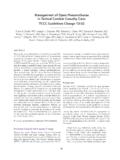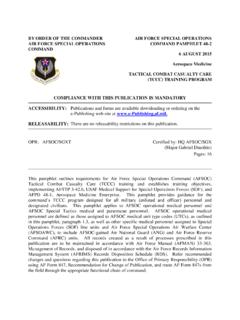Transcription of The Tactical Combat Casualty Care Casualty Card …
1 The Tactical Combat Casualty care Casualty card TCCC Guidelines Proposed Change 1301. 30 April 2013. COL Russ S. Kotwal, USA. CAPT Frank K. Butler, USN (Ret.). MSG Harold R. Montgomery, USA. CDR Tyson J. Brunstetter, USN. Capt George Y. Diaz, USAF. COL James W. Kirkpatrick, USA (Ret.). Ms. Nancy L. Summers Col Stacy A. Shackelford, USAF. COL John B. Holcomb, USA (Ret.). Col Jeffrey A. Bailey, USAF. DISCLAIMER: The recommendation contained herein is the official position of the Department of Defense Joint Trauma System Committee on Tactical Combat Casualty care . This recommendation is intended to be a guideline only and is not a substitute for clinical judgment. This document was reviewed by the Director of the Joint Trauma System, the Public Affairs Office, and the Operational Security Office at the Army Institute of Surgical Research and approved for unlimited public release as of 30 April 2013.
2 Form Approved Report Documentation Page OMB No. 0704-0188. Public reporting burden for the collection of information is estimated to average 1 hour per response, including the time for reviewing instructions, searching existing data sources, gathering and maintaining the data needed, and completing and reviewing the collection of information. Send comments regarding this burden estimate or any other aspect of this collection of information, including suggestions for reducing this burden, to Washington Headquarters Services, Directorate for Information Operations and Reports, 1215 Jefferson Davis Highway, Suite 1204, Arlington VA 22202-4302. Respondents should be aware that notwithstanding any other provision of law, no person shall be subject to a penalty for failing to comply with a collection of information if it does not display a currently valid OMB control number.
3 1. REPORT DATE 2. REPORT TYPE 3. DATES COVERED. 01 JUL 2013 N/A - 4. TITLE AND SUBTITLE 5a. CONTRACT NUMBER. The Tactical Combat Casualty care Casualty card TCCC Guidelines ? 5b. GRANT NUMBER. Proposed Change 13-01. 5c. PROGRAM ELEMENT NUMBER. 6. AUTHOR(S) 5d. PROJECT NUMBER. Kotwal R. S., Butler F. K., Montgomery H. R., Brunstetter T. J., Diaz G. 5e. TASK NUMBER. Y., Kirkpatrick J. W., Summers N. L., Shackelford S. A., Holcomb J. B., Bailey J. A., 5f. WORK UNIT NUMBER. 7. PERFORMING ORGANIZATION NAME(S) AND ADDRESS(ES) 8. PERFORMING ORGANIZATION. REPORT NUMBER. United States Army Institute of Surgical Research, JBSA Fort Sam Houston, TX. 9. SPONSORING/MONITORING AGENCY NAME(S) AND ADDRESS(ES) 10. SPONSOR/MONITOR'S ACRONYM(S). 11. SPONSOR/MONITOR'S REPORT. NUMBER(S). 12. DISTRIBUTION/AVAILABILITY STATEMENT.
4 Approved for public release, distribution unlimited 13. SUPPLEMENTARY NOTES. 14. ABSTRACT. 15. SUBJECT TERMS. 16. SECURITY CLASSIFICATION OF: 17. LIMITATION OF 18. NUMBER 19a. NAME OF. ABSTRACT OF PAGES RESPONSIBLE PERSON. a. REPORT b. ABSTRACT c. THIS PAGE. UU 9. unclassified unclassified unclassified Standard Form 298 (Rev. 8-98). Prescribed by ANSI Std Z39-18. Abstract Optimizing trauma care delivery is paramount to saving lives on the battlefield. During the past decade of conflict, trauma care performance improvement at Combat support hospitals and forward surgical teams in Afghanistan and Iraq has increased through Joint Trauma System and DoD Trauma Registry data collection, analysis, and rapid evidence-based adjustments to clinical practice guidelines. Although casualties have benefitted greatly from a trauma system and registry that improves hospital care , still lacking is a comprehensive and integrated system for data collection and analysis to improve performance at the prehospital level of care .
5 Tactical Combat Casualty care (TCCC) based Casualty cards, TCCC after action reports, and unit-based prehospital trauma registries need to be implemented globally and linked to the DoD Trauma Registry in a seamless manner that will optimize prehospital trauma care delivery. Background In 2007, a Committee on Tactical Combat Casualty care (CoTCCC) working group was convened to address the lack of prehospital care documentation in the conflicts in Iraq and Afghanistan. At that point in time, there were over 30,000. casualties from these conflicts, but less than 10% of these casualties' records had any documentation of the care that was provided before the Casualty reached a medical treatment facility. Unit-level reporting formats were used in almost all cases of successful documentation.
6 It was noted at the conference that, in many instances, the first responders providing care were not medical personnel. Documentation of care provided by non-medical first responders requires a format that they understand and can use effectively. (Butler 2010) The DD Form 1380 Field Medical card that was in use by the DoD at the time was not believed by conference attendees to be optimally configured for documenting first responder care on the battlefield. Three possible choices for battlefield trauma care documentation were reviewed at the conference. One was the DoD paper form 1380. The second was the Battlefield Medical Information System Tactical (BMIS-T) a PDA device. Neither format was felt to sufficiently meet the needs of the prehospital providers in the Tactical environment.
7 The third option was the Casualty card that had been developed by the 75th Ranger Regiment. This card was identified by the working group as an immediate, cost-effective, and easily-fielded interim solution. This card was developed largely by Ranger medics, has proven easy to use, and has been very well-accepted by the Rangers and by other Special Operations groups. Using this format, the Ranger Regiment had effectively documented the care provided to almost all of the approximately 450 battle injury and non-battle injury casualties they had sustained in Iraq and Afghanistan at the time of the 2. conference. This card was recommended by conference attendees and endorsed by the CoTCCC as the preferred method for documenting TCCC on the battlefield. The 2007 version of the TCCC Casualty card is shown in Figure 1.
8 (Butler 2010). The TCCC Casualty card was endorsed by the Defense Health Board (Wilensky 2009) and adopted as the standard format for documenting prehospital care by the Department of the Army. (ALARACT 2009) The applicable Army Regulation (AR 40-66 Medical Record Administration and Healthcare Documentation) was amended to permit the TCCC Casualty card (DA Form 7656) to become a part of the Health Record without a medical officer's signature. The DD 1380 Field Medical card requires a medical officer's signature in order to become a part of the Health Record. The TCCC Casualty card was used successfully by the Ranger Regiment to create the Ranger Prehospital Trauma Registry, which is the single best unit-based trauma registry to emerge from the conflicts in Afghanistan and Iraq and which enabled the most comprehensive study on prehospital care rendered in a Combat unit to emerge from these conflicts.
9 (Kotwal 2011). Only 14% of casualties have pre-hospital care documented upon arrival at a Role II/III facility. The lack of consistent prehospital documentation of care continues to be a requirement gap across the Services. (Caravalho 2011). Discussion Points There have been a number of updates to TCCC since the current version of the Casualty care card was adopted in 2007. These new interventions include TXA, the CRoC, ketamine, and others. Although the previous TCCC Casualty card was designated as an approved Army form, the other services did not follow the lead of the Army on this issue. There is a need to have a form that is acceptable to and used by all services in the DoD. The Defense Medical Materiel Program Office has noted this need and initiated the effort to have a single DD form approved for use throughout the DoD.
10 The revised card maintains the simple format of the previous card , but incorporates a number of modifications that will allow better documentation of prehospital care . Upgrades included in the revised TCCC card include: - The Casualty Battle Roster Number (to link to the DoD Trauma Registry). - Better definition of the mechanism of injury - Improved documentation of tourniquet use - Adds a section to record the use of junctional tourniquets - Incorporates the use of prehospital plasma and blood - Provides for documentation of hemoglobin oxygen saturation - Adds a section for documentation on pain level 3. - Incorporates a section for supraglottic airway use - Provides a space for the type of supraglottic airway - Provides a space for type of chest seal - Adds ketamine in the analgesic section - Incorporates the use of tranexamic acid - Provides a space for documentation of an eye shield - Provides a space for documentation of Combat pill pack usage - Provides a space for documentation of hypothermia prevention equipment The draft of the updated card was developed as a joint effort of the CoTCCC, the DMMPO, and the JTS.














